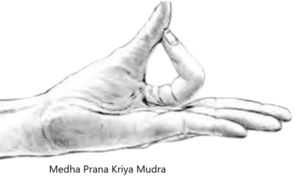Medha Prana Kriya Mudra
Visual inspiration: While not the exact depiction of Medha Prana Kriya Mudra, this image reflects a similar finger-tip placement—you can use it as a reference for hand positioning.
Introduction
Medha Prana Kriya Mudra—meaning “gesture for sharpening mental clarity through vital energy purification”—is a mindful mudra designed to enhance mental vigor and clarity. The term comes from Sanskrit:
Medha = mental acuity or wisdom
Prana = life force or vital energy
Kriya = action or purification
This mudra purifies prana to uplift cognitive functions and stabilize emotions.
Meaning
Medha Prana Kriya Mudra is often referred to as the “Mudra for the Brain: Non-Resistance.” It encourages a welcoming, non-reactive approach to thoughts and emotions—perfect for mindfulness and meditation, especially for beginners.
How to Perform
Sit in a comfortable meditative posture (e.g., Sukhasana, Padmasana).
Touch index finger nails to the middle joint of the thumb and apply light pressure, extend all other fingers and turn palms up.
Maintain upright spine, relaxed shoulders, and steady gaze or closed eyes.
Practice with both hands simultaneously.
Benefits
Activates breath in the rib cage, especially the middle thoracic region.
Slows respiration, promoting calmness and ease.
Increases cerebral blood flow, enhancing mental clarity.
Stimulates discriminative thinking and wisdom centers in the brain.
Cultivates a stance of non-resistance to thoughts or emotions.
Balances Kapha and Pitta doshas, aligning energetic harmony.
Encourages acceptance during mindfulness—“welcoming thoughts and feelings” rather than suppressing them.
Contraindications
No explicit contraindications are documented in the sources.
General guidance suggests using it thoughtfully during meditation, especially if one is emotionally injured or unstable, as it magnifies engagement with mental content.
Anatomy & Physiology
Likely activates intercostal muscle engagement, enhancing breath flow.
Reduced respiration may increase oxygenation and cerebral perfusion, aiding cognition.
Kinesiology
The pressing of index finger into the thumb joint and steady extension of the remaining fingers creates a subtle isometric engagement that supports mindfulness posture and focus.
Neurology
Encourages activation of prefrontal and sensory cortex areas, supporting attention and emotional regulation.
Supports the mind–body integration needed for mindful awareness.
Duration of Practice
Best for short mindfulness sessions—for example, hold for 4–5 breaths initially.
Can be held longer during meditation, depending on comfort and focus.
There are no strict limits—listen to your body and mind.
Counter Mudra
If the meditative process stirs discomfort, consider:
Chin Mudra – for grounding and calming.
Shakti Mudra – for deep relaxation.
Hakini Mudra – for mental focus if thoughts feel scattered.

